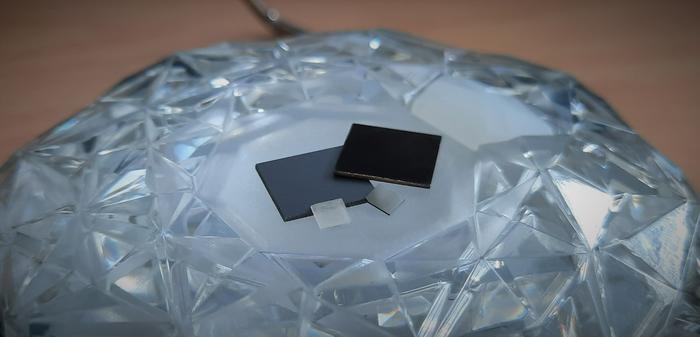| Sep 21, 2023 |
Diamond materials as solar-powered electrodes - spectroscopy shows what's important
(Nanowerk News) It sounds like magic: photoelectrodes could convert the greenhouse gas CO2 back into methanol or N2 molecules into valuable fertiliser - using only the energy of sunlight. An HZB study (Small Methods, "Surface-mediated charge transfer of photogenerated carriers in diamond") has now shown that diamond materials are in principle suitable for such photoelectrodes.
|
|
By combining X-ray spectroscopic techniques at BESSY II with other measurement methods, Tristan Petit's team has succeeded for the first time in precisely tracking which processes are excited by light as well as the crucial role of the surface of the diamond materials.
|
|
At first glance, lab-grown diamond materials have little in common with their namesakes in the jewellery shop. They are often opaque, dark and look not spectacular at all. But even if their looks are unimpressive, they are promising in many different applications, for example in brain implants, quantum sensors and computers, as well as metal-free photoelectrode in photo-electrochemical energy conversion. They are fully sustainable and made of carbon only, they degrade little in time compared to metal-based photoelectrodes and they can be industrially produced!
|
 |
| Four diamond materials are shown here: “Diamond black” made of polycrystalline nanostructured carbon (top right), the same material before nanostructuring (top left), an intrinsic single crystal (bottom left) and a single crystal doped with boron (bottom right). (Image: A. Chemin, HZB)
|
|
Diamond materials are suitable as metal-free photoelectrodes because when excited by light, they can release electrons in water and trigger chemical reactions that are difficult to initiate otherwise. A concrete example is the reduction of CO2 to methanol which turns the greenhouse gas into a valuable fuel. It would also be exciting to use diamond materials to convert N2 into nitrogen fertiliser NH3, using much less energy than the Haber-Bosch process.
|
|
However, diamond electrodes oxidize in water and oxidized surfaces, it was assumed, no longer emit electrons into the water. In addition, the bandgap of diamond is in the UV range (at 5.5 eV), so visible light is unlikely to be sufficient to excite electrons. In spite of this expectation, previous studies have shown puzzling emission of electrons from visible light excitation. A new study by Dr. Tristan Petit's group at HZB now brings new insights and gives cause for hope.
|
|
Dr Arsène Chemin, a postdoctoral researcher in Petit's team, studied samples of diamond materials produced at the Fraunhofer Institute for Applied Solid State Physics in Freiburg. The samples were engineered to facilitate the CO2 reduction reaction: doped with boron to insure good electrical conductivity and nanostructured, which gives them huge surfaces to increase the emission of charge carriers such as electrons.
|
|
Chemin used four X-ray spectroscopic methods at BESSY II to characterize the surface of the sample and the energy needed to excite specific electronic surface states. Then, he used the surface photovoltage measured in a specialised laboratory at HZB to determine which ones of these states are excited and how the charge carriers are displaced in the samples. In complement, he measured the photoemission of electrons of samples either in air or in liquid. By combining these results, he was able for the first time to draw a comprehensive picture of the processes that take place on the surfaces of the sample after excitation by light.
|
|
"Surprisingly, we found almost no difference in the photoemission of charges in liquid, regardless of whether the samples were oxidized or not," says Chemin. This shows that diamond materials are well suited for use in aqueous solutions. Excitation with visible light is also possible: in the case of the boron-doped samples, violet light (3.5 eV) is sufficient to excite the electrons.
|
|
"These results are a great cause for optimism," says Chemin: "With diamond materials we have a new class of materials that can be explored and widely used." What’s more, also the methodology of this study is interesting: The combination of these different spectroscopic methods could also lead to new breakthroughs in other photoactive semiconductor materials, the physicist points out.
|

